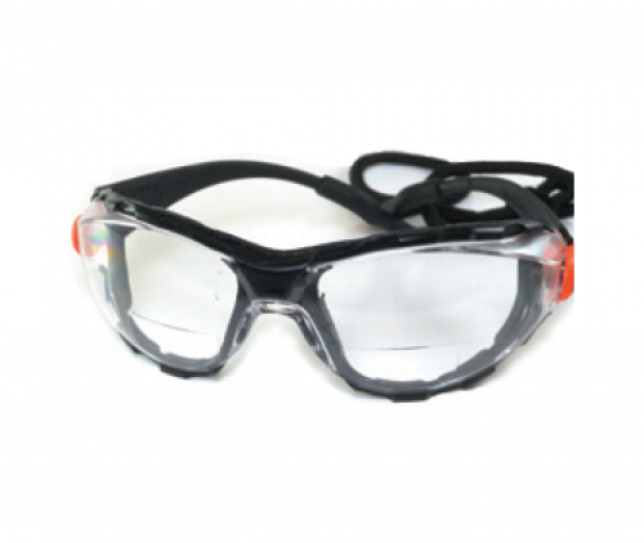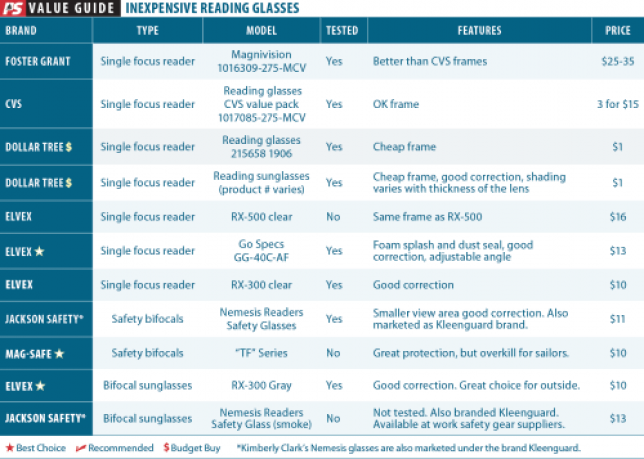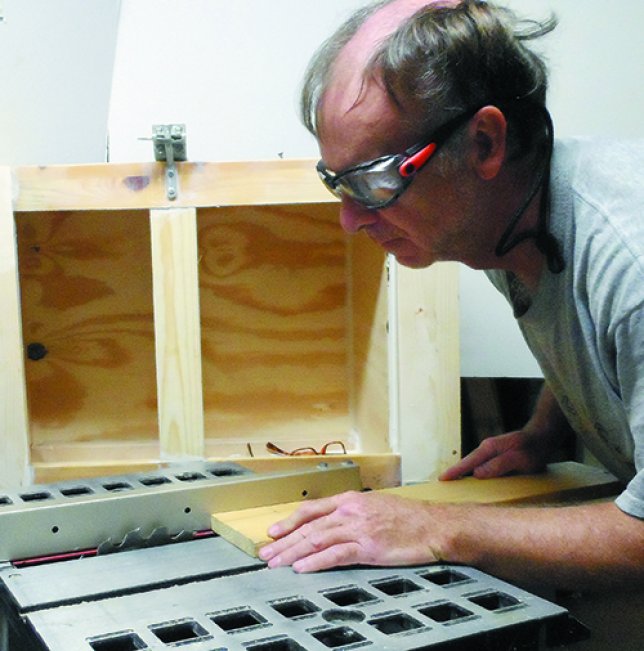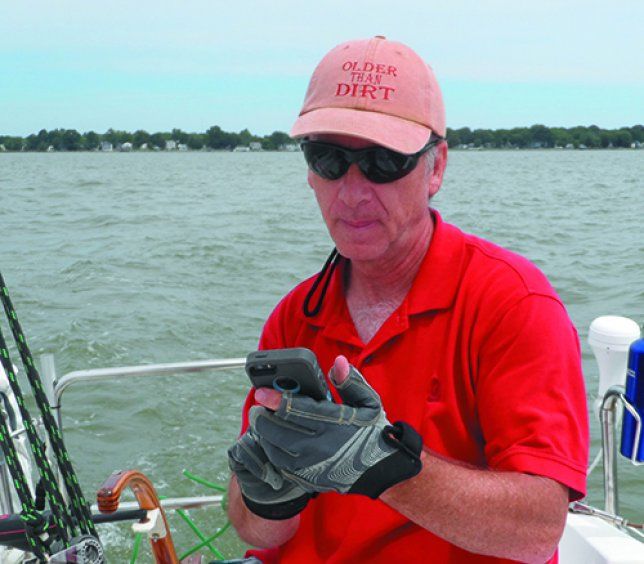I swore off prescription glasses for sailing five years ago after donating one last pair to Neptune. It’s not just the cost, but also the mental angst you feel. If underway, they are just gone. If at the dock, you’ll be fishing for them with a net or going for an unscheduled swim. Retention cords help, but if I’m also wearing a cord on my hat, annoying tangles ensue. On the other hand, when a pair of drugstore glasses goes in the drink it doesn’t ruin your day. And then I learned that the local dollar store had suitable glasses for a buck; I’m wearing them as I type this. I won’t win any fashion awards, but when I drop them or sit on them, its less bothersome than spilling a soda. I like that.
Observations
For the most part, over the counter (also known as cheaters in the bifocal safety glasses form) glasses are only for those with age related farsightedness. At a certain age your arms start getting longer, the result of the lens becoming less flexible and losing the ability to focus over a wide range of distances. In my case it became obvious when my preschool daughter started pressing books into Daddy’s face, far too close for me to focus. I could read signs in the distance as normal, but not anything within 18 inches. Of course, there are other factors that can affect your vision, so when things get blurry, see an ophthalmologist. In addition to accessing your eyes for more serious problems, you will get a prescription, describing the required curvature of curvature of lenses.

Diopter. If you do not have astigmatism (non-spherical distortion of the lens), the prescription will tell you what strength over the counter glasses you need. Although primarily for farsighted correction (positive diopter), nearsighted corrections (negative diopter) are available on-line.
Interpupil Distance. If your eye spacing is average, over the counter should be close enough. If they are closely set, try women’s glasses. If more widely set, try wide frame models. This is a minor factor with weak prescriptions, but becomes progressively more important at a diopter of about 3.0 (either near or far sighted) or greater.
Reading Glasses. I prefer single vision for reading, computer work, and most mechanical work. I can see the entire page at a glance, and when working in tight spaces, it eliminates the need to move my head to access the bifocal areas, which may not be possible.
Sunglasses. Single vision is nice for reading a book in bright sun, but for sailing I find the bifocal (also known as cheaters) version more useful. The upper portion allows me to see the rigging and across the water, and the bifocal allows me to read instruments and charts, saving a lot of yanking glasses on and off.
Safety Glasses. Prescription glasses deserve protection from the paint spots and pockmarks that come from boat work. They also fall short in side impact and splash protection. Goggles worn over glasses can work, but they are too hot and uncomfortable for all-day work. Safety glasses with clear plastic in the top and a bifocal on the bottom are a more wearable solution. As a consulting engineer complaining about visitor goggles in a refinery, I was introduced to these by contractors. There are dozens of models and brands to choose from. This review covers a few that I favor, but the best choice probably comes down to individual tastes and fit.
Safety glasses are also available in single vision correction, just the thing for sustained grinding or mechanical work where you need full vision or can’t turn your head. They are also available in top bifocals, handy for people who work overhead (mechanics working under lifts and some electricians).
When trying on cheap glasses, be sure to look through the corners. Really cheap glasses many be fine straight ahead but distorted near the edges. For boat use, I favor sturdiness over style. These are working glasses, not fashion items.

Reading Your Prescription
The departure of the lens in your eye from ideal is approximated in terms of a round lens, cylindrical lens, and a wedge. These are incorporated into the stack of test lenses the doctor flashes in front of you eyes while asking better or worse:
-
- OD/OS OD is right eye. OS is left eye.
-
- Sph (spherical correction). This is the diopter of a round lens, with no correction for distortion, also know as astigmatism.
-
- Cyl (cylindrical correction). This is the diopter of a cylinder that approximates the distortion.
-
- Axis. This is the angle of the top of the cylinder from the outside horizontal.
-
- Prism. This is a wedge, from top to bottom. Another descriptor of astigmatism.
-
- Base. This describes the orientation of the prism base. BU = base up; BD = base down; BI = base in (toward the wearers nose); BO = base out (toward the wearers ear). It is analogous to axis.
-
- IP distance. This is the distance of the pupil from the centerline. The left and right values are added together. Most often this is not a part of the prescription, but rather is measured by the person fitting the glasses, since the location of the center of the lens varies with how the frame sits on your nose.
An ideal candidate for over the counter reading glasses has no cylinder or prism correction. If the distance correction is weak, less than about +2.5, you will typically be fine without distance correction in full daylight; your pupils contract, and like a pinhole camera, increases your depth of field. Distance correction single vision readers may be helpful driving at night or watching movies.
The reading diopter may be expressed either as a plain number, or as add x.xx, in which case that value is added to the spherical correction listed above it.
Over-the-counter glasses for nearsighted corrections are not available at the typical drug store, but may be ordered on-line. Pricing is similar to the more common farsighted reading glasses. Cheater safety glasses for nearsightedness or astigmatism are not available; these must be prescription.
Dollar Tree Readers
Who would have thought it possible, that a functional lens could be put in a frame and brought to market for a buck? Available at Dollar Tree stores (and Dollar Tree online) they are also a boon to folks like me that drop glasses overboard, sit on them, and cover them with paint. Available in a range of forgettable metal and plastic frames of questionable durability, in diopters from 1.25 to 3.25. Treated poorly, they typically only last a few months, but for $1.00, thats fair. Watch out for lenses that distort in the corners and frames that are crooked.
Bottom line: A Budget Buy if there ever was one.
CVS Brand Readers
The frames are a step up from the Dollar Tree glasses, though still not approaching prescription quality. Weve had these last through years of intermittent use, failing only when we good and truly step on them.
Bottom line: A Budget Buy on a par with Dollar Tree, and worth the price because they last longer.
Foster Grant Reading Glasses
Common in drugstores, the quality of the frames is better yet, perhaps approaching low-end prescription quality. However, in spite of claims about optical quality lenses, we observed distortion in the corners and rate the lenses little better than Dollar Store glasses. Pricing ranges from $25-35.
Bottom line: More stylish than other options, but who cares on the boat?
Hydrotac Stick-On Bifocals
Ive used these in full face respirators and was not satisfied. The distance of the lens from the eye is generally too great and they can come loose during cleaning. I was happier inserting cut-down reading glasses (PS Sept 2017, Checking Respirators for Fit). On the other hand, Ive known people who liked them in dive masks. Because they are attached only by a slight inherent stickiness (like cling wrap) they can be transferred between eyewear.
Bottom Line: They might work for you.
Safety Glasses
Safety glasses must offer complete protection and resist fogging when sweating.
Elvex RX-300 Clear

Wrap around safety glasses with a bifocal on the bottom, these are an industry standard. Light, comfortable, and reasonably good vision. Also available as sunglasses (RX-300 gray).
Bottom line: A reliable choice that I often use.
Elvex RX-500 Clear
These are the same as the RX-300, but in single vision.
Bottom line: These were rated as Recommended for sustained, close work.
Elvex Go-Spex
Foam seals provide improved protection from dust and splashes, making these a good choice for grinding and use with corrosive chemicals. Although not as protective as goggles, they’re a lot more wearable. In hot weather, they do make your eyes sweat.
Bottom line: These are my all-around industry and boat yard favorites.
Jackson Nemesis Bifocal
Very similar to the RX-300. Also available as sunglasses (Nemesis Gray).
Bottom line: Another solid choice.
Mag-Safe TF-series
Top-notch bifocal safety glasses, but bulkier than other choices.
Bottom line: Unless you work under a lift, probably not what you want.
Conclusions
My prescription glasses havent gone near the boat in years. For general duty I keep a few pairs of dollar store readers in my bag. If a pair goes in the drink, I just smile and reach for another pair. I have a pair of bifocal safety sunglasses (Elvex RX-300) the serve well for sailing, and a pair of bifocal safety glasses (Elvex Go-Specs) for boat work. Ive been happy with most brands and believe it comes down to fit.\
Drew Frye is Technical Editor for Practical Sailor and author of Rigging Modern Anchors. He blogs at his website www.blogspot.sail-delmarva.com.








































I am pleased to not I am not the only one that has resorted to $1 sun glasses ( Polaroid brand) and cheap $1 readers for boat use. I got sick and tired of losing and breaking those $$$$ sunglasses.
Smile as you throw another piece of plastic trash in our waterways. As a construction millwright I wear prescription safety glasses about 3000 hours a year in far worse conditions than any boat yard. My current pair of wiley-x glasses are great and have never fallen off.
Well, I need prescription glasses whether they be clear/photo gray, or sunglasses. If I’m painting I’ll wear protective glasses over them for splatter protection. When sailing I wear my prescription RayBan framed prescription mirrored sunglasses.. I’m extremely photophobic ( but have very good night vision), so I wear them dawn to dusk when I’m outside. If I don’t, then nasty headaches are the expected norm. I’ve got a great optometrist/optician who thankfully knows what I need.
By the way, I believe your article goes too deeply into technical optics for most people, including me, who either would be bored reading through it, or drop out of reading partway through the article. I find this more than occasionally while reading PS. Stick more to sailing stuff.
FYI, Online sources like Zenni optical will provide prescription glasses and sun glass for a very cheap price. My pair of prescription polarized sunglasses cost less than $50. I also use a costa glasses band that was $6 just in case and have never had an issue since.
While cheap glasses are ok in a pinch there can be no comparison with a pair of polarized sunglasses with your exact prescription
-Ocean State Job-Lot (Now moving up & down the east coast…finally in NY) has been my source for years! Also have many great buys for those of us who don’t have money to burn in almost all shopping categories.
– In the Hospital I used their cheaters to read the impossibly small information on vials, etc.
If they became contaminated or damaged another pair or 3 were always in my ‘work bag’!
Motorcycle shops sell good wrap-around glasses. I use them for skiing and sailing in areas where I don’t need to see beneath the water–they typically are not polarized. At $20 they’re much cheaper than ski goggles. I carry a dark and an amber pair so I can change to deal with light changes.
Unlike Ed White above, I found the brief discussion of the “details” useful and informative, concise, and then on to the more universally interesting comparisons of the products. Just enough info to help us determine if the products under consideration were suitable for “my own visual needs” or not. I like this article, personally useful to me. Thanks.